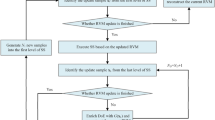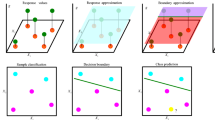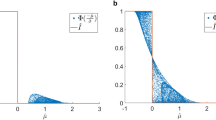Abstract
In this work, a new reliability method is proposed by combining the relevance vector machine (RVM) and importance sampling in a proper way. A modified Metropolis algorithm is utilized to generate the training data that covers the important area. With the training data, a surrogate model is built with RVM to approximate the limit state surface. Then importance sampling is introduced to make sure that the surrogate model can be used in the area where it is built. In addition, a small portion of the importance samples in the vicinity of the limit state are selected and then evaluated with the original performance function to update the estimate of failure probability. These measures are integrated into a double-loop iteration by the proposed method. Discussions with numerical and engineering examples have evidenced the applicability and adaptability of the proposed method, even for cases involving non-normal variables or rare failure probabilities. It proves to be very economic in terms of the number of calls to the original performance function while ensuring an acceptable level of accuracy.












Similar content being viewed by others
References
Au SK, Beck JL (1999) A new adaptive importance sampling scheme for reliability calculations. Struct Safe 21:135–158
Au SK, Beck JL (2001) Estimation of small failure probabilities in high dimensions by subset simulation. Probab Eng Mech 16(4):263–277
Au SK, Beck JL (2003) Subset simulation and its application to seismic risk based on dynamic analysis. J Eng Mech ASCE 129(8):901–917
Berger JO (1985) Statistical decision theory and Bayesian analysis, 2nd edn. Springer, New York
Bourinet JM, Deheeger F, Lemaire M (2011) Assessing small failure probabilities by combined subset simulation and support vector machines. Struct Safe 33:343–353
Chapman OJV, Crossland AD (1995) Neural networks in probabilistic structural mechanics, in: probabilistic structural mechanics handbook. Chapman & Hall, New York
Dai H, Zhang H, Wang W (2012) A support vector density-based importance sampling for reliability assessment. Reliab Eng Syst Safe 106:86–93
Dubourg V, Sudret B, Deheeger F (2013) Metamodel-based importance sampling for structural reliability analysis. Probab Eng Mech 33:47–57
Echard B, Gayton N, Lemaire M (2011) AK-MCS: an active learning reliability method combining Kriging and Monte Carlo simulation. Struct Safe 33:145–154
Echard B, Gayton N, Lemaire M, Relun N (2013) A combined importance sampling and Kriging reliability method for small failure probabilities with time-demanding numerical models. Reliab Eng Syst Safe 111:232–240
Elegbede C (2005) Structural reliability assessment based on particles swarms optimization. Struct Safe 27:171–186
Hu C, Youn BD, Yoon H (2013) An adaptive dimension decomposition and reselection method for reliability analysis. Struct Multidiscip Optim 47(3):423–440
Hurtado JE (2007) Filtered importance sampling with support vector margin: a powerful method for structural reliability analysis. Struct Safe 29(1):2–15
Hurtado JE, Alvarez DA (2001) Neural-network-based reliability analysis: a comparative study. Comput Methods Appl Mech 191(1–2):113–132
Hurtado JE, Alvarez DA (2003) Classification approach for reliability analysis with stochastic finite-element modeling. J Struct Eng ASCE 129(8):1141–1149
Kiureghian AD (2000) The geometry of random vibrations and solutions by FORM and SORM. Probab Eng Mech 15(1):81–90
Li J, Xiu D (2010) Evaluation of failure probability via surrogate models. J Comput Phys 229:8966–8980
Li J, Li J, Xiu D (2011) An efficient surrogate-based method for computing rare failure probability. J Comput Phys 230:8683–8697
MacKay DJC (1992) Bayesian interpolation. Neural Comput 4(3):415–447
Melchers RE (1989) Importance sampling in structural system. Struct Safe 6(1):3–10
Pradlwarter HJ, Schuëller GI, Koutsourelakis PS, Charmpis DC (2007) Application of line sampling simulation method to reliability benchmark problems. Struct Safe 29(3):208–221
Proppe C (2008) Estimation of failure probabilities by local approximation of the limit state function. Struct Safe 30(4):277–290
Rackwitz R (2001) Reliability analysis-a review and some perspectives. Struct Safe 23(4):365–395
Richard B, Cremona C, Adelaide L (2012) A response surface based on support vector machines trained with an adaptive experimental design. Struct Safe 39:14–21
Rocco CM, Moreno JA (2002) Fast Monte Carlo reliability evaluation using support vector machine. Reliab Eng Syst Safe 76(3):237–243
Romero VJ, Swiler LP, Giunta AA (2004) Construction of response surface based on progressive-lattice-sampling experimental designs with application to uncertainty propagation. Struct Safe 26(2):201–219
Samui P, Lansivaara T, Kim D (2011) Utilization relevance vector machine for slope reliability analysis. Appl Soft Comput 11(5):4036–4040
Schuëller GI, Pradlwarter HJ, Koutsourelakis PS (2004) A critical appraisal of reliability estimation procedures for high dimensions. Probab Eng Mech 19(4):463–473
Sciuva MD, Lomario D (2003) A comparison between Monte Carlo and FORMs in calculating the reliability of a composite structure. Compos Struct 59(1):155–162
Tipping ME (2001) Sparse bayesian learning and the relevance vector machine. J Mach Learn Res 1:211–244
Vapnik VN (2000) The nature of statistical learning theory. Springer, New York
Widodo A, Yang BS (2011) Application of relevance vector machine and survival probability to machine degradation assessment. Expert Syst Appl 38(3):2592–2599
Yuan X, Lu Z, Zhou C, Yue Z (2013) A novel adaptive importance sampling algorithm based on Markov chain and low-discrepancy sequence. Aerosp Sci Technol 29(1):253–261
Ziha K (1995) Descriptive sampling in structural safety. Struct Safe 17:33–41
Acknowledgments
This work is supported by Nature Science Foundation of China (51175425) and Development Fund for Important Program of NWPU (3102014ZD0031).
Author information
Authors and Affiliations
Corresponding author
Rights and permissions
About this article
Cite this article
Changcong, Z., Zhenzhou, L., Feng, Z. et al. An adaptive reliability method combining relevance vector machine and importance sampling. Struct Multidisc Optim 52, 945–957 (2015). https://doi.org/10.1007/s00158-015-1287-z
Received:
Revised:
Accepted:
Published:
Issue Date:
DOI: https://doi.org/10.1007/s00158-015-1287-z




